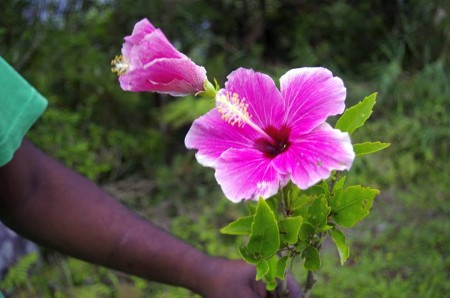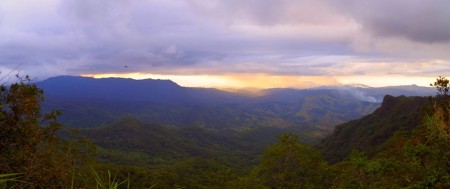- In remembrance of apples past.
- What makes for an “outstanding lentil“?
- Sweet potatoes finally get a taste of the wild.
- A tree for every season: ICRAF pushing trees both local and exotic.
- Can Zambian supermarkets support local farmers AND make money? Should get some of those tree products in there.
- Touring the oldest botanical gardens would make for a great round-the-world trip.
- Though I’d probably want to add a quick diversion to taste hallucinogenic honey in Nepal.
- ‘Twas pepper built Venice. That and bread.
- Defence-related genes important in seed longevity.
- What the heck are microgreens? And will they be discussed at the International Symposium on Biodiversity and Edible Wild Species in Turkey next November?
Brainfood: Wild barley diversity double, Sesame diversity, Coconut genome size, Giant anteater, Sucking mangoes, Teff development, PhilRice, Korean soybeans, Coffee forest management, Switchgrass diversity, Yam diversity
- Analysis of Correlations Between Climate and Molecular Adaptive Evolution of Wild Barley with Geographical Information Systems (GIS). Some genes are associated with climatic variables in wild barley, others not so much.
- Molecular Genotyping of Historical Barley Landraces Reveals Novel Candidate Regions for Local Adaption. Latitudinal structuring in northern European barley landraces down to 7 SNPs. Not clear if related to above.
- Morphological and genetic diversity assessment of sesame (Sesamum indicum L.) accessions differing in origin. Not much geographic structure.
- Ploidy and domestication are associated with genome size variation in Palms. Tall coconuts show more variation in genome size than dwarfs.
- Protected areas effectiveness in maintaining viable giant anteater (Myrmecophaga tridactyla) populations in an agricultural frontier. I just wanted to link to a paper on the giant anteater.
- Genetic Diversity in Seedling Populations of Mango. What exactly are “sucking purposes”?
- Diversifying crops for food and nutrition security — a case of teff. Hipsters will save orphan crops.
- Conservation of Rice Genetic Resources for Food Security. In the Philippines genebank, that is.
- Soybean [Glycine max (L.) Merrill]: Importance as A Crop and Pedigree Reconstruction of Korean Varieties. 168 of 178 varieties released in the last 100 years in Korea can be traced to 4 pedigrees.
- In-situ Conservation of wild forest coffee — Exploring the potential of participatory forest management in south west Ethiopia. It’s the communities, stupid.
- Switchgrass Germplasm Resources. Upland and lowland ecotypes, different ploidy levels, latitudinal differentiation, and a national collection at USDA to play with.
- Participatory evaluation of Guinea yam (Dioscorea cayenensis Lam.–D. rotundata Poir. complex) landraces from Benin and agro-morphological characterization of cultivars tolerant to drought, high soil moisture and chips storage insects. 5-15% of over 400 varieties (including duplications) are good for one thing or another.
Hibiscus lost and found
Hibiscus storckii is one of the original, native species hibiscus plants that is a probable ancestor to the modern hibiscus hybrids. It was discovered and named by a botanist visiting the island of Fiji in the 1800s. Expeditions to the island since then have not located any surviving examples of this species of hibiscus still growing on Fiji. The flowers are pink and white, and the bush is small, full, and well-branched. Kew Botanical Gardens in England received cuttings of this species directly from the botanist who discovered it and fortunately has been able to grow it continually ever since.
Yeah, well, the bit about the species not being found in Fiji is happily no longer the case. Because my friend Lex Thomson has just posted this photo on Facebook:

And, to make you (and me) even more envious, here’s where it was found:

I do love it when a wild relative, and a beautiful one at that, turns up in something other than an herbarium specimen. Thanks to Lex and his CSIRO colleague David Bush for letting us bring you the news, and the pix.
Nibbles: Seed Hunter, Corn Palace, Rice domestication, Solomons cocoa, Simran Sethi book, Cucurbit diseases, Brazilian foodies, Ananas genome, GMOs in Argentina
- Seed Hunter visits genebank. Not many people hurt.
- I’d like to visit this Corn Palace.
- Rice domestication: not once, not twice, three times. Well, really, who’s to say maybe even more than that? Maybe even in Australia?
- Solomon Islands cacao wins award. Looking forward to tasting it one day. But is it certified?
- Bread, Wine, Chocolate: The Giveaway.
- Researchers hoping to science the shit out of threat to Thanksgiving.
- Genetic resources and gastronomy in Brazil.
- Pineapple gets a genome.
- Sunflower saves soybean? What wizardry is this?
Brainfood: Wild maize, Elderberry phenolics, Barley & boron, Land sparing trifecta, Sustainable diets, Chinese apple diversity, Turkish okra diversity, Barcoding yams, Plant diversity levels, Biotic velocity
- Presence of Zea luxurians (Durieu and Ascherson) Bird in Southern Brazil: Implications for the Conservation of Wild Relatives of Maize. Well there’s a turnup for the books.
- Fruit Phenolic Composition of Different Elderberry Species and Hybrids. Some interspecific hybrids have high phenolics levels.
- Diversity in boron toxicity tolerance of Australian barley (Hordeum vulgare L.) genotypes. There’s variation beyond the 4 known boron tolerance loci.
- Agriculture and the threat to biodiversity in Sub-Saharan Africa. Intensification is good for biodiversity, but not yet.
- Land for Food & Land for Nature? The former, according to modelling. But it depends. See above.
- Wildlife-friendly farming increases crop yield: evidence for ecological intensification. Trifecta!
- Is a Cardio-Protective Diet Sustainable? A Review of the Synergies and Tensions Between Foods That Promote the Health of the Heart and the Planet. Yes, but it will take some work.
- Genetic diversity of Malus cultivars and wild relatives in the Chinese National Repository of Apple Germplasm Resources. The varieties from the former Soviet republics and Japan are different to each other and to the canonical European/North American/Chinese material.
- Genetic and phenotypic variation of Turkish Okra (Abelmoschus esculentus L. Moench) accessions and their possible relationship with American, Indian and African germplasms. Turkish okra comes from all over the place.
- DNA barcoding of the main cultivated yams and selected wild species in the genus Dioscorea. 16/21 species I guess is a start.
- Plant responses to climatic extremes: within-species variation equals among-species variation. For a bunch of European grassland plants, within species variation in response to climate was as high as that among species.
- Biotic and Climatic Velocity Identify Contrasting Areas of Vulnerability to Climate Change. Tropical species can’t move fast enough.